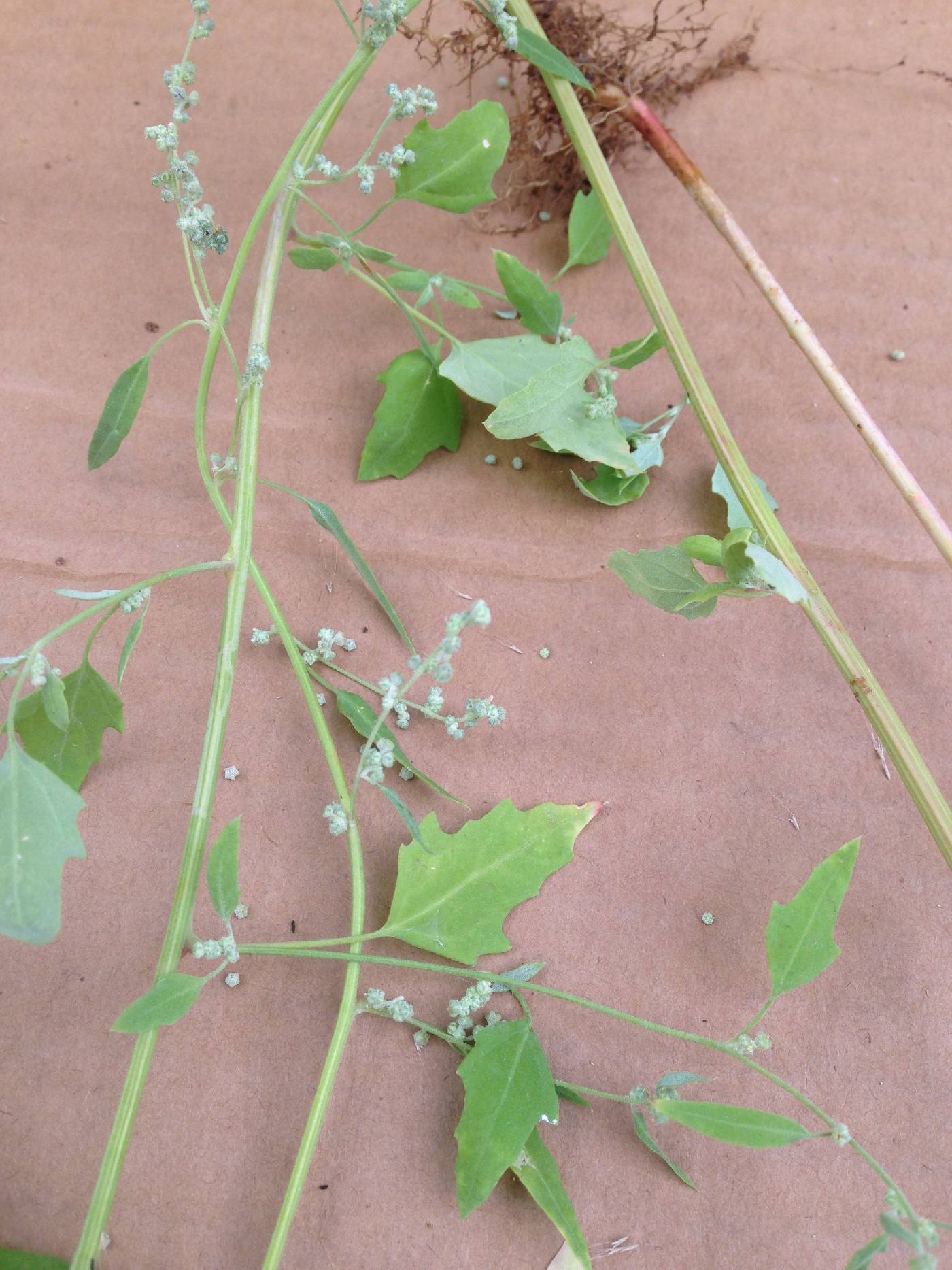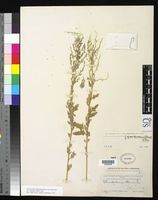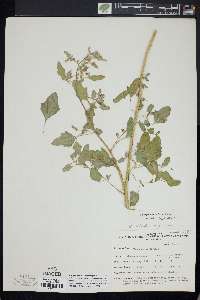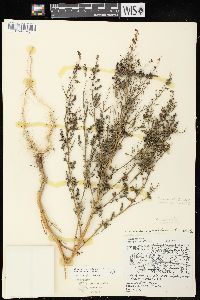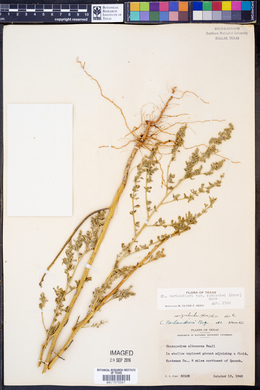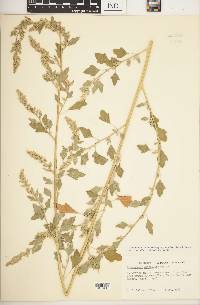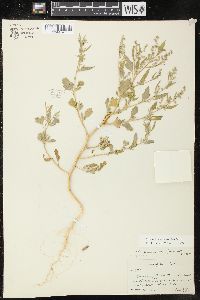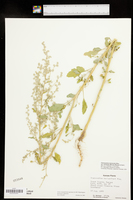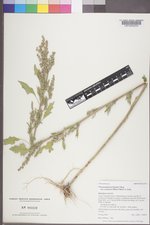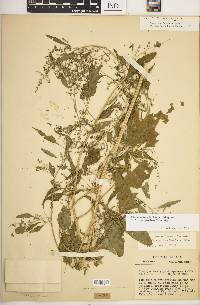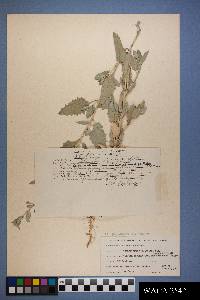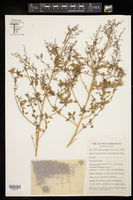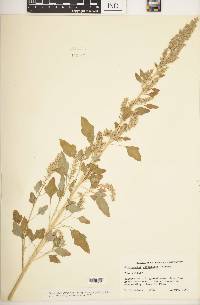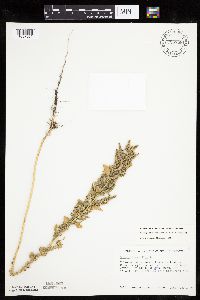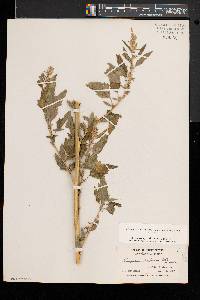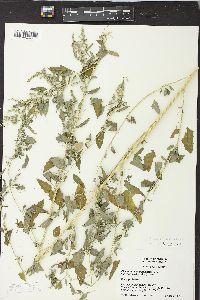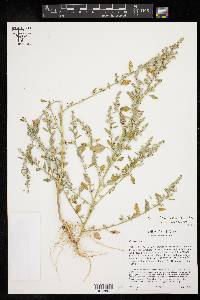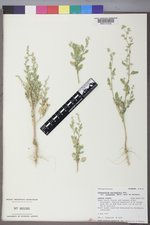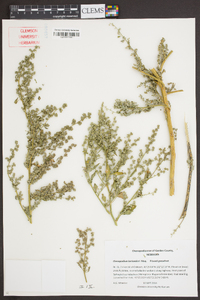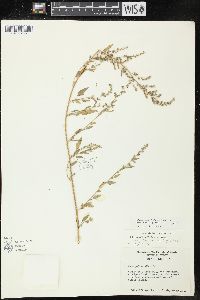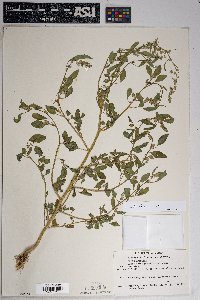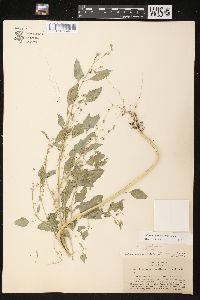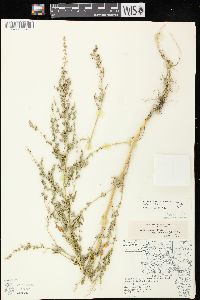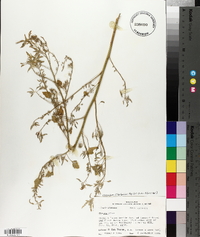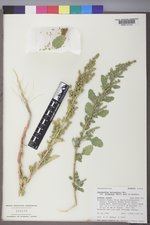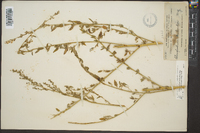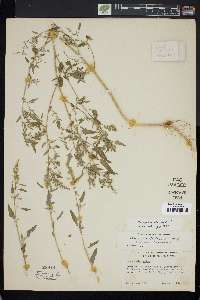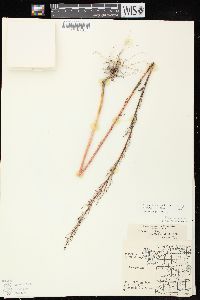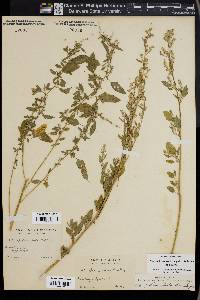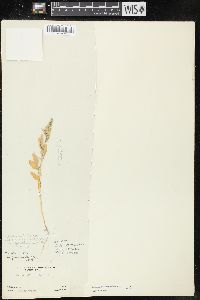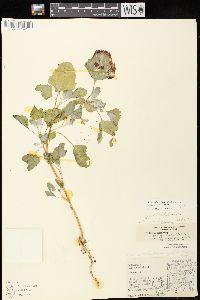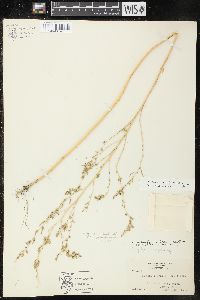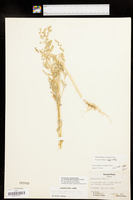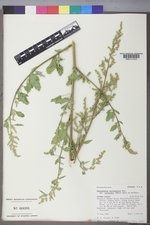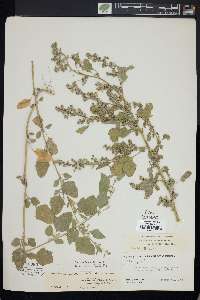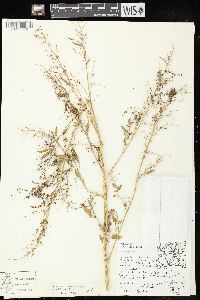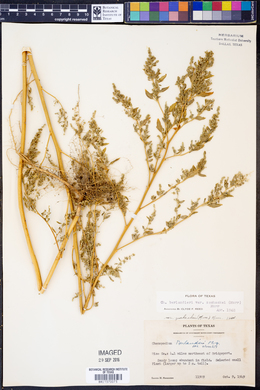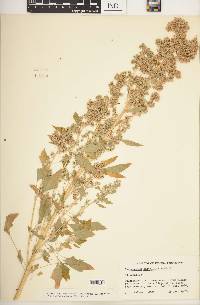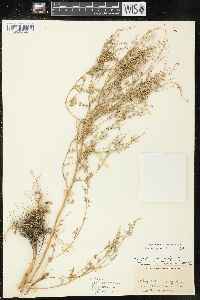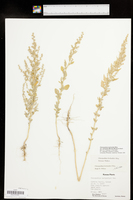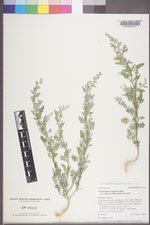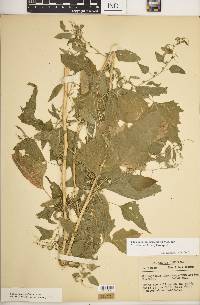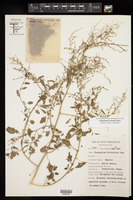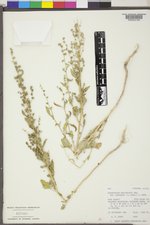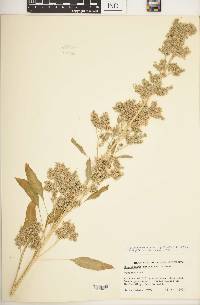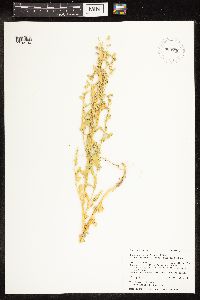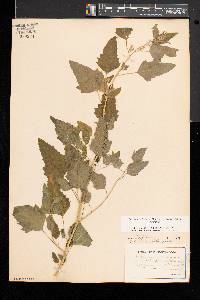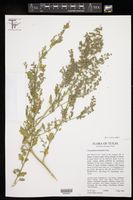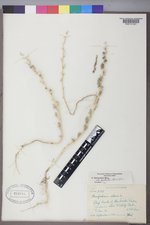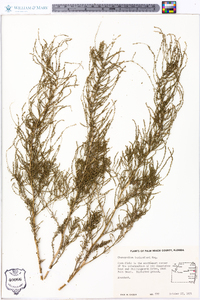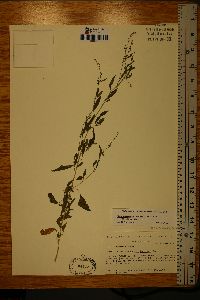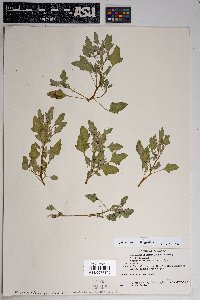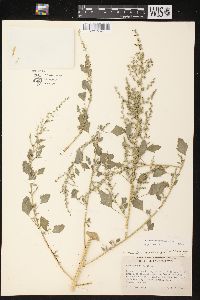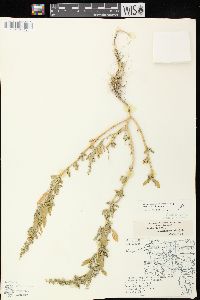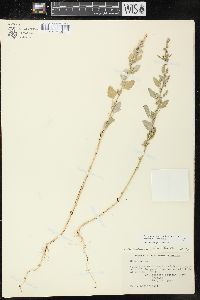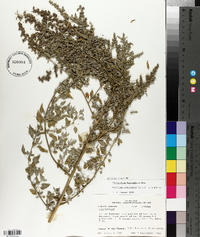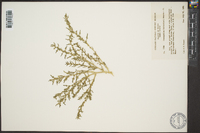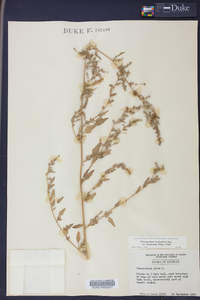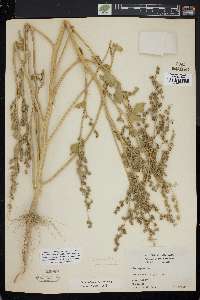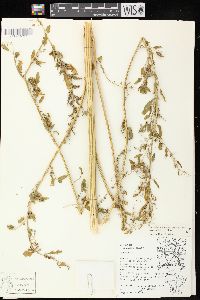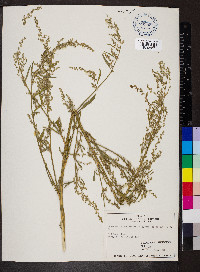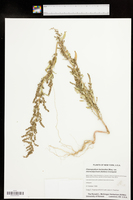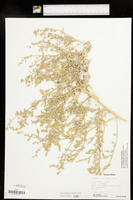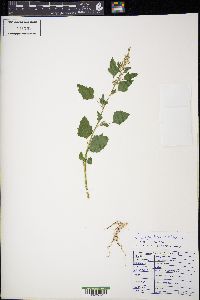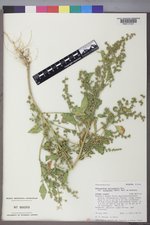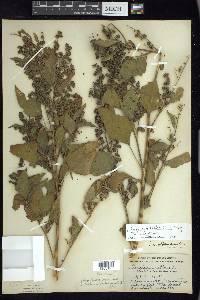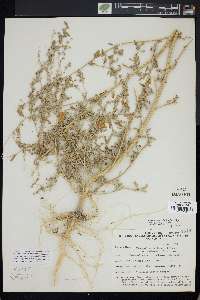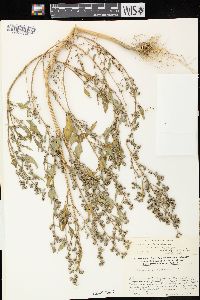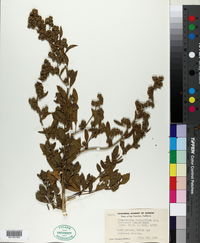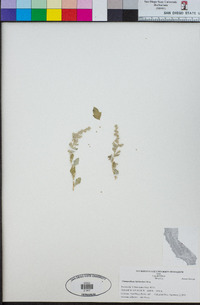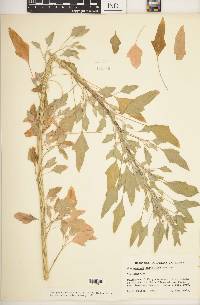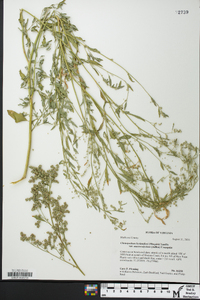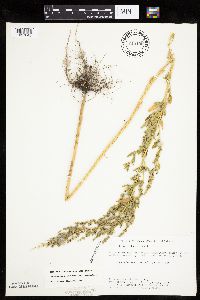Chenopodium berlandieri
|
|
|
|
Family: Amaranthaceae
Pit-Seed Goosefoot, more... (es: bledo)
|
Stems erect to ascending, much-branched to simple, 1-10.5 dm, farinose. Leaves nonaromatic; petiole 0.2-9 cm; blade narrowly to broadly lanceolate, rhombic, ovate, or triangular, 1.2-12(-15) × 0.5-7.5(-9) cm, base cuneate to truncate, margins serrate, irregularly dentate, or entire, often with 2 basal lobes, apex acute to acuminate, farinose. Inflorescences glomerules in compound spikes, 5-17 cm; glomerules irregularly rounded, 4-7 mm diam.; bracts absent. Flowers: perianth segments 5, distinct nearly to base; lobes ovate to deltate, 0.7-1.5 × 0.7-1.3 mm, apex obtuse, farinose, often prominently keeled, covering fruit at maturity or not; stamens 5; stigmas 2, 0.3-0.5 mm. Achenes or utricles depressed-ovoid; pericarp adherent or nonadherent near stylar base, alveolate-rugose. Seeds round, 1-2 mm diam., margins rounded; seed coat brown to black, honeycomb pitted. 2n = 36. Annual herb 10 cm - 1 m tall Stem: upright to ascending, unbranched to much-branched, white-mealy. Leaves: alternate, on a 0.2 - 9 cm long stalk, 1 - 15 cm long, 0.5 - 9 cm wide, narrowly to broadly lance-shaped or egg-shaped or diamond-shaped or triangular with a flat to tapering base and pointed tip, sometimes irregularly toothed to toothed, often two-lobed basally, white-mealy. Inflorescence: a 4 - 7 mm wide, dense, irregularly rounded cluster of flowers (glomerule), which together form a 5 - 17 cm long, compound spike. Flowers: greenish, small, with five nearly distinct sepals and no petals. Sepal lobes 0.5 - 1.5 mm long, egg-shaped to triangular with a blunt apex, often prominently keeled, white-mealy. Stamens five. Stigmas two. Fruit: one-seeded (achene or utricle), sometimes enclosed in the persistent, incurved sepals, blackish, or with a light yellowish area around the style, depressed egg-shaped, thin-walled. Wall (pericarp) adherent or non-adherent to the seed, honeycomb-like. Seed brown, 1 - 2 mm wide, round, round-margined, honeycomb-like. Similar species: No information at this time. Flowering: late June to mid-October Habitat and ecology: Introduced from Europe. A weed of cultivated and waste ground. Occurence in the Chicago region: non-native Etymology: Chenopodium comes from the Greek words chen, meaning goose, and podion, meaning "little foot," referring to the leaf shape of some species. Berlandieri is named after Jean Louis Berlandier (1805-1851), the botanist who discovered the species. Author: The Morton Arboretum FNA 2004, Kearney and Peebles 1969, McDougall 1973 Duration: Annual Nativity: Native Lifeform: Forb/Herb General: Herbaceous annuals, 10-150 cm tall; stems erect to ascending, much-branched to simple; herbage farinose. Leaves: Alternate, petiolate, nonaromatic, and farinose; petiole 0.2-9 cm; blade lanceolate, rhombic, ovate, or triangular, often with 2 basal lobes, 1-12 cm long by 0.5-8 cm long, with a cuneate to truncate base, irregularly dentate or entire margins, and an acute to acuminate apex. Flowers: Inconspicuous, green, and clustered, the clusters (glomerules) arranged in panicles 5-17 cm long; glomerules irregularly rounded, 4-7 mm diameter; perianth segments 5, farinose, often prominently keeled, covering fruit at maturity. Fruits: Utricles depressed-ovoid, the pericarp adherent or nonadherent near base of style, rough honeycombed; with round seeds 1-2 mm diameter, brown to black, minutely pitted. Ecology: Widespread, often in disturbed habitats below 8,000 ft (2438 m). Distribution: Ranges all across the western United States and into Mexico. Notes: Chenopodium is a genus of usually weedy annual herbs with simple, alternate leaves, herbage that is commonly farinose (with mealy, or floury hairs) to some degree, and clusters of small green flowers lacking petals, which mature into fruits composed of a single seed wrapped in the persistent calyx. The leaves of C. berlandieri are farinose on the underside but can be glabrous above, and usually have irregular, shallow teeth or lobes. It is similar to several other Chenopodiums, with differences being that this species has relatively large, dense glomerules of flowers; the calyx adheres tightly to the fruit at maturity; seed coats are pitted; and the leaves have shallow teeth in the margins. C. fremontii has mostly entire leaves with only a pair of lobes at the base, and smooth seeds; C. album has leaves that are similar to C. berlandieri but the seeds are smooth or only lightly ridged. In general, mature seeds are necessary for conclusive ID of any species within the Chenopodium genus. Look for it in Chenopodiaceae in older texts; that entire family is now considered to be part of Amaranthaceae. Ethnobotany: Leaves are edible. Etymology: Chenopodium is goose foot in Latin, berlandieri is named after Jean Louis Berlandier (1805-1851) a Belgian botanist. Synonyms: None Editor: SBuckley 2010, AHazelton 2015 Much like C. album, but the pericarp evidently roughened and cellular-reticulate when viewed at 10נ(or in any case at 20ש; a minute (0.1 mm) undivided style-base persistent on the fr (at least in var. zschackei); 2n=36. Common native Amer. weed, widespread in our range and s. into Mex. Three ±distinguishable vars. with us: Gleason, Henry A. & Cronquist, Arthur J. 1991. Manual of vascular plants of northeastern United States and adjacent Canada. lxxv + 910 pp. ©The New York Botanical Garden. All rights reserved. Used by permission. From Flora of Indiana (1940) by Charles C. Deam ...... Indiana Coefficient of Conservatism: C = 0 Wetland Indicator Status: UPL Diagnostic Traits: leaves usually ill-scented, glabrous to somewhat scurfy-scaly beneath; flowers in dense glomerules; sepals sharply-keeled, acute apex, often enclosing the mature seed; pericarp and seed with honeycomb pattern. |
|
|
|

